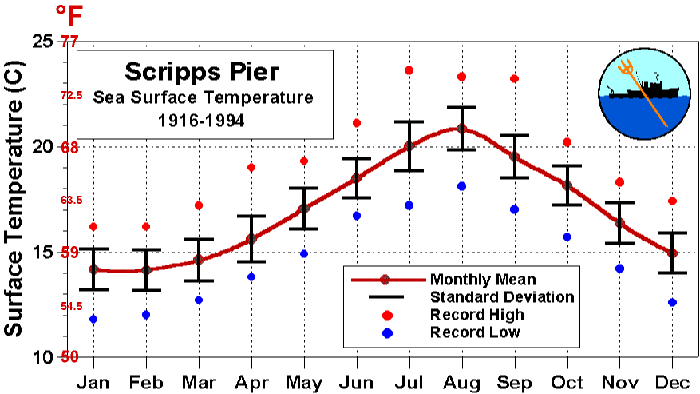General Diving Conditions in San Diego
This page is intended for people who are new to diving in San Diego and want to know generally what our conditions are like.
Let's get one thing straight from the beginning:
San Diego's below water conditions are generally cold and dark! You ARE NOT coming to dive in the Caribbean or South Pacific.
That said, we love diving here. San Diego has a very large, very active diving community. Many divers can be found out by the water nearly every weekend. So when I say that it's cold and dark, don't think that the diving sucks here; the diving is frequently great, it's just not warm and great visibility.
Visibility
Average shore diving visibility in the La Jolla area (where most of the shore diving occurs) is 10–20 feet. It can be as bad as 2 feet, and as good as 30–40 feet. The visibility is a bit better if you get offshore, and any of the local dive boat operators would be most happy to take you offshore. At certain times of the year, we get plankton blooms (generally late spring / early summer), during which the nearer-to-the-surface water has really bad visibility but below that the visibility usually opens up nicely. At these times, the plankton layer will block a lot of sunlight, so the dives will be closer to night dives during the day, depending on how bad the plankton bloom is. Note that many of these plankton blooms are &lquot;red tides&rquot;, which produce fantastic blue bioluminescence at night.
This introduces two general rules: (1) just because the surface water looks like nasty pea soup does not mean that you cannot get below the nasty pea soup and find nice visibility, and (2) in a similar vein, just because the surface conditions are not good (good-sized swell, lots of wind chop, etc.) doesn't mean that you won't find really nice conditions at depth. You just never know until you get there.
Water Temperature
This is highly variable. Some of the coldest dives you'll find might actually be during summer. However, generally: summer surface will be high 60s to low 70s, summer depth will be low 60s to high 60s. But don't be surprised by low 50s at depth during summer. Winter surface will be high 50s to low 60s, winter depth will be very low 50s to high 50s, with the occasional 49 degrees thrown in. (All of this in degrees Fahrenheit.)
Below is a graph modified from one available on the SIO website (look at Longterm Sea Surface Temperature Statistics on the SIO Weather Page). Credit is given to the Climate Research Division, Scripps Institution of Oceanography, University of California, San Diego.

Thermal Protection
Many divers in San Diego dive drysuits. Many dive wetsuits. For the wet suit divers, you will want a 6mm or 7mm wetsuit, in one or two pieces. If you're diving a one-piece, in winter you will want to include a hooded vest. The hood should also be fairly thick (5mm or 6mm). Nearly everyone dives with gloves and a hood. Tropical style gloves will not work here in winter (and probably not in summer). A good pair of 5mm gloves, or a brand-new pair of 3mm gloves and a bit of prayer will work.
Where to Dive If You Are a Beginner
Several general comments... If you're really, really a beginner, find someone with more experience and who knows the area, and dive with them. Got a friend in San Diego who dives? Or maybe try one of the local dive clubs, some of which have weekly dives open to anyone. Or try getting a dive master at a local dive shop to take you out. If you're a beginner but not still dry behind the ears, at least talk with some locals before you decide where to head out. Also, dive boats and non-shore diving are always an option. And, finally, please read the dive site descriptions on this website for these dive sites before heading out there to dive. That way you will know, for example, to only dive Hospital Point at high tide so that you won't get your head bashed in (unless it's completely flat). That said,
| Great conditions |
La Jolla Cove, epecially in close (right or left) Boomers at La Jolla Cove The Caves at La Jolla Cove The Marine Room reefs Hospital Point Children's Pool Scripps Pier ...and anywhere else you might want to go! (consider North County dive sites) |
| OK-but-not-great conditions |
The Rockpile at La Jolla Cove maybe in closer at La Jolla Cove? Children's Pool (if you're comfortable with the entry/exit) The Main Wall / Vallecitos Point at La Jolla Shores The North Wall at La Jolla Shores (have a local find it for you) |
| Getting questionable conditions | The Main Wall / Vallecitos Point at La Jolla Shores The North Wall at La Jolla Shores (have a local find it for you) Breakfast |
| Downright bad conditions | Breakfast at the Papalulu's, or The Cottage, or Harry's, or John's Waffle Shop, or ... ???? |
To the locals who want to know why other La Jolla Canyon dive sites and Scripps Canyon are left out: this list is intended for fairly new divers.